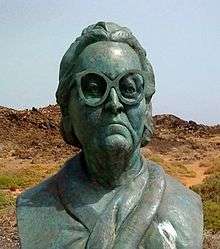Josefina Pla
| Josefina Pla | |
|---|---|
 Statue on Isla de Lobos, Canarias, Spain | |
| Background information | |
| Birth name | Josefina Pla |
| Born |
9 November 1903 Isla de Lobos, Canarias, Spain |
| Died |
11 January 1999 (aged 95) Asuncion, Paraguay |
| Occupation(s) | Poet, Painter, Journalist |
Josefina Pla (9 November 1903 in Isla de Lobos, Canary Island, Spain – 11 January 1999 in Asunción, Paraguay) was a Spanish poet, playwright, art critic, painter and journalist.
She received numerous awards and distinctions for her literary work, for defending human rights and the equality between men and woman.
Living the other one that I am that wasn’t what would have been.
Living what would have been dying which I am still not.
Sleeping all was I, another waking I go.
- Nos habremos deseado tanto / que el beso habrá muerto. Desnudo día, 1936
- We will have wanted each other so bad / that the kiss will have died. Naked day, 1936
Early life
Josefina Pla was born in Isla de Lobos, Canarias, the daughter of Leopoldo Plá and Rafaela Guerra Galvani. She spent her childhood in diverse cities of Spain with her father, a functionary of provinces.
In 1924, she met the Paraguayan artist Andres Campos Cervera in Villajoyosa, Alicante; they married two years later.
Artistic career
In 1925, she went to Paraguay and first established herself in Villa Aurelia and Asunción. In that same year, she presented her writings in the youth magazine, Speaker of the Writers' Generation of Paraguayan Postmodernism. From there until 1938, she traveled twice to Spain with her husband.
Her husband died in 1937. She came back to Paraguay a year later and headlined with Hérib Campos Cervera, nephew of her husband.
Throughout her life, she received several awards, gabardines and nominations, including: The Lady of Honour of the Order of Isabel la Católica (1977); the member of the International Ceramic Academy in Geneva, Switzerland; the founding member of the PEN Paraguayan Club; the "Ollantay" trophy to the theatre investigation of Venezuela (1984); the "woman of the year" in (1977); the Bicentenary Medal of the United States of America (1976); the condition of Counsel of the Vice Minister of the Paraguayan Culture, the National Order of Merit in the commendatory grade of the Paraguayan Government in (1994), her Human Rights defence recognition given by the International Society of Jurist, the Beautiful Arts Gold Medal of Spain (1995), the Johann Gottfried von Herder Medal, member of the Paraguayan Linguistic Academy of Paraguayan and Spanish history, finalist of the Merit Contest for the “Príncipe de Asturias” award (1981), the postulation for the "Cervantes award", top recognition for the Hispanic letters in the years 1989 and 1994, the "Ciudadanía Honoraria" given by the Paraguayan Parliament in 1998, among others.
In the 1950s, she was a co-founder of the "New Art Group" along with fellow artists Olga Blinder, Lilí De Mónico and José Laterza Parodi.
Pla died on 11 January 1999 in Asuncion.
Works
Her work covers the field of literary creation – more than forty titles in poetry, narrative and theatre, the social and cultural history of Paraguay, the ceramic, painting and critic, by which, with justice is considered the highest, fundamental referent in the Paraguayan Cultural Subject in the last century. She frequently collaborated with Roque Centurión Miranda in writing many of her plays, particularly from 1942.
| Year | Works |
|---|---|
| 1934 | "The price of dreams" |
| 1960 | "The rooth and dawn" |
| 1965 | "Faces in the water"
"Death invention" |
| 1966 | "Dark Satelites" |
| 1968 | "The dust in love"
"Naked day" |
| 1975 | "Black light" |
| 1927–1977 | "Poetic Anthology" |
| 1982 | "Time foliage", "Time and darkness" |
| 1984 | "Changing dreams for shadows". |
| 1985 | "The flame and sand".
"The thirty thousand absents". |
| 1996 | "The imposible absent" |
Her dramatic production includes, since 1927 until 1974, "Víctima propiciatoria", "Episodios chaqueños" (with Roque Centurión Miranda), "Porasy" (opera script with music of Otakar Platal), "Desheredado", "La hora de Caín", "Aquí no ha pasado nada", "Un sobre en blanco", "María inmaculada", "Pater familias" (all with Roque Centurión Miranda), "La humana impaciente", "Fiesta en el río", "El edificio", "De mí que no del tiempo", "El pretendiente inesperado", "Historia de un número", "Esta es la casa que Juana construyó", "La cocina de las sombras", "El professor", "El pan del avaro", "El rey que rabió" y "El hombre de oro" (the last three, are children pieces), "La tercera huella dactilar", "Media docena de grotescos brevísimos", "Las ocho sobre el mar", "Hermano Francisco", "Momentos estelares de la mujer (short pieces series)", "Don Quijote y los Galeotes", "El hombre en la cruz", "El empleo" y "Alcestes".
Her piece about Cultural and Social Paraguayan History includes the following titles: "La cultura paraguaya y el libro", "Literatura paraguaya del Siglo XX", "Apuntes para una historia de la cultura paraguaya", "Arte actual en el Paraguay", "Cuatro siglos de teatro en el Paraguay", "Impacto de la cultura de las Reducciones en lo Nacional", "Apuntes para una aproximación a la Imaginería Paraguaya", "El Templo de Yaguarón", "El barroco hispano-guaraní", "Las artesanías en el Paraguay", "Ñandutí. Encrucijada de dos mundos", "El espíritu del fuego", "El libro en la época colonial", "Bilingüismo y tercera lengua en el Paraguay", "Españoles en la cultura del Paraguay", "La mujer en la plástica paraguaya" and "The British in Paraguay, 1850 - 1870" (translated by B.C. McDermot).
References
- Centro Cultural de la República
- Diccionario Biográfico "FORJADORES DEL PARAGUAY", Primera Edición Enero de 2000. Distribuidora Quevedo de Ediciones. Buenos Aires, Argentina.